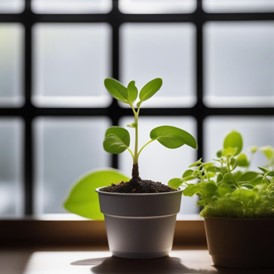
Contents
Learning Outcome Time required Tools or equipment required Summary of the activity What to do Tips how to implement the topic to school curriculumLearning Outcome
After finishing this activity, a student will have learned to
- How to pre-grow seedlings
- Skills needed to organize a school event associated with the sale of products
- More about composting and waste management issues
- Skills needed to grow your own fruit and vegetables
Time required
- 45 minutes planting
- about 6 weeks growing
- 45 mins administration if placed at the city square
- 45–120 mins selling
- 45 mins feedback
Tools or equipment required
- Empty food containers (yogurt cups are ideal)
- Composted soil
- Vegetable seeds, or optionally strawberry seeds
Optional: Drill/candle and nail
Summary of the activity
The activity is similar to a school fair associated with the sale of food. It may be prohibited in some states to sell processed foods without appropriate certification for legal reasons. As an alternative, the sale of seedlings grown by students in the school building is suggested.
Thanks to the use of composted soil, students will learn more about the possibilities of recycling biodegradable waste, and the use of empty plastic containers for growing plants is an additional benefit of the activity.
At the end, students will organize the sale of their seedlings, which will foster relationships with the local community.
The seedlings are grown in classrooms on windowsills, so no additional energy sources are consumed during the cultivation process, as would be the case with commercial greenhouse cultivation.
This activity can be further connected to hydroponics, žížalárium and school market activities.
What to do
1. Introduction of the topic
- Introduce the activity to your students and discuss organizational matters:
- Who will take care of how many plants?
- Which plants will we grow?
- Involvement of other classes?
- Organic seeds?
- Who and how will handle the promotion of the sale?
- Setting the price for the seedlings
- Who will handle the documentation of the activity?
2. Resources for teachers
Informations about how to grow seedlings indoor:
- How to Start Seeds Indoors: The Complete Guide
- Video about the same topic
- Information on when to start growing - Starting Seeds Indoors: How and When to Start Seeds
- Article about the return on investment in growing your own crops
- Information about composting
3. Implementation
The implementation of the activity involves collecting empty and washed plastic food containers (e.g., yogurt cups) for a certain period. Get the selected seeds and enough compost soil. At the designated time, prepare the containers for planting, fill them with compost soil up to about one centimetre below the top edge, water them, plant the seeds, and place the containers on a windowsill. If you plant tomato seeds, choose the highest containers and fill the soil only to one-fourth at the beginning. Add more soil gradually as the tomato grows and strengthens. After the time needed for growing seedlings, encourage students to organize a school fair where they offer the seedlings for sale. You can use the school premises, but it would be more suitable to arrange the fair in collaboration with the city authorities on a town square, for example, to maximize the impact of the activity.
After the activity, it is advisable to evaluate it, and students should answer the following questions:
- What did I like about the activity?
- How much (on a scale of 1-10) do I consider the activity beneficial?
- How did people who bought the seedlings perceive the activity?
- What did I contribute to the smooth running of the activity?
- What would I do differently next time?
- What should the activity organizers do differently next time?
4. Promotion
Publish the documented results on the school website or social media.
Optional (but highly recommended)
You can purchase composted soil at a local composting facility, and if possible, include a tour of the composting facility in the program (for example: https://www.centralnikompostarna.cz/).
Another way to obtain compost is to establish a school compost bin where plant waste from the school's operations can be thrown, and you can also involve the school kitchen. Check if there is an EU subsidy program available in your country that allows for the purchase of subsidized compost bins (in the Czech Republic 2014-2020). However, remember that it takes about a year for the plant waste to turn into compost.
You can provide better growing conditions by making several holes in the bottom of the flowerpot for excess water to drain out. These holes can be drilled using a drill, or a nail heated over a flame. In this case, it is necessary to place a tray or dish under the flowerpot to catch the excess water.
Tips how to implement the topic to school curriculum
This activity can be incorporated into various subjects in the school curriculum.
In the field of economics, students can calculate costs, determine margins, and set business goals.
In biology, they can explore plant classification and growth, and if optionally extended to include composted soil and the process of plant residue decomposition.
In mathematics, basic mathematical operations such as expressing germination rates in percentages can be included
